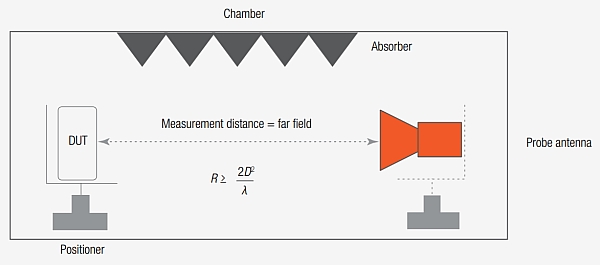- With the advent of 5G telecommunications, more and more devices will operate frequencies in the millimeter wave (mmWave) range. Each of these devices of various sizes and for different applications requires specific architectures and antenna sizes.
- The operation of these antennas must be validated by Over The Air (OTA) tests in an anechoic test chamber.
- The direct far-field (DFF) and indirect far-field (IFF) test methods by compact antenna test range (CATR) are the two OTA test methods supported by the 3GPP TR 38.810 study on test methods for 5G FR2 devices (mmWave bands)
# DFF or Direct far-field test configuration:

When the direct far field method (DFF) is used, the tested device (DUT) is mounted on a positioner which rotates in azimuth and elevation, allowing the object to be measured at any angle over the entire 3D sphere. The DFF method allows the most complete tests to be performed by measuring several signals, but requires a larger test chamber for millimetre wave devices: a 4.2 m chamber for a 15 cm to 28 GHz radiating device results in excessive propagation loss. Due to its ability to measure several signals, this method is still the preferred method for devices operating at frequencies below 6 GHz.
# IFF or Indirect far-field test configuration:

The IFF test method is based on a CATR (compact antenna test range) that creates a far-field test environment using a parabolic reflector that parallelizes the waves transmitted by the probe antenna. Inside the test chamber, the object under test radiates a wavefront to a remotely located antenna reflector that then collimates the radiated spherical wavefront to a receiving antenna. The distance between the object under test and the receiver is sufficient for the emitted spherical wave to reach the transmitter to the receiver with almost flat phase edges during its propagation. Although this method measures a single signal, it requires a much shorter distance between the antenna and the object under test and causes less propagation loss than the DFF method for testing devices communicating at frequencies in the millimeter wave domain (mmWave).






